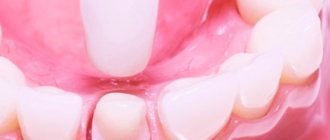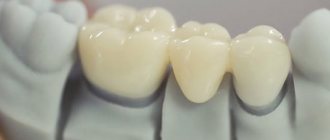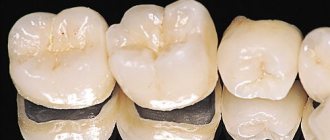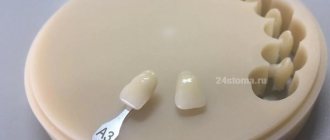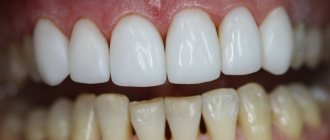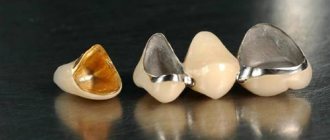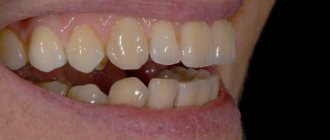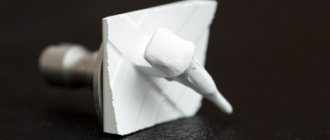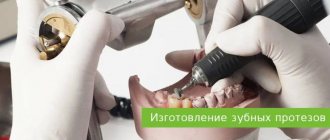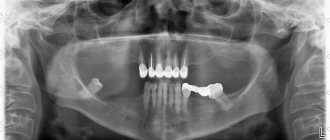From this article you will learn:
- what is Emax – reviews, before and after photos,
- its comparison with zirconium dioxide,
- Emax crowns and veneers – price 2022.
Metal-free ceramics E-max is the best option for dental prosthetics with crowns, veneers, and bridges up to 3 units in length. This material provides excellent aesthetics, and if you want artificial dental crowns or veneers to blend in as closely as possible with adjacent teeth in color and translucency, Emax material is a good choice. It is produced for dentistry (Liechtenstein).
Emax ceramics consists of 70% lithium disilicate crystals, which allows this material to be classified as glass ceramics. Thanks to the optical parameters of the glass matrix, this material has increased light transmittance, which makes its optical properties as similar as possible to the enamel of real teeth. Therefore, reviews of E-max ceramic crowns or veneers made from this material are good even among the most aesthetically demanding patients.
Appearance and transparency of E-max –
In this article we will discuss both the advantages and disadvantages of E-max ceramics, which make its use undesirable in a number of clinical situations. We will also compare E-max veneers and ceramic crowns with other types of metal-free ceramics (for example, zirconium dioxide or feldspathic ceramics) so that you can understand which denture ceramics will be best in your case.
Types of E-max ceramics –
There are 2 main options for E-max ceramics for the manufacture of veneers and crowns - these are “IPS E-max RPESS” and “IPS E-max CAD”. The indications for their use are very different, as are the technologies for making restorations from these materials, and therefore we will talk about each of them separately.
1) IPS “E-max RPESS” (pressed ceramics) –
E-max RPESS is a glass ceramic designed for injection molding under high temperature and pressure conditions. Pressed ceramics E-max has a very high strength - 400 MPa, which is several times greater than the strength not only of pressed ceramics made from any other materials, but also the strength of E-max CAD.
The excellent aesthetics of the material, together with high strength, make it possible to make from E-max RPESS not only single crowns, but also bridges of up to 3 units inclusive, and even ultra-thin veneers and lumineers. E.max RPESS significantly exceeds the aesthetic capabilities of another type of metal-free ceramic - zirconium dioxide, both due to the greater transparency of the material and due to a greater number of color shade options (Fig. 4-9).
Clinical case No. 1 – before and after photos
Clinical case No. 2 – before and after photos
In addition to the classic material “E-max RPESS”, there is also an improved version called “E-max RPESS Multi”. The second material differs from the first in that it is polychrome (that is, it has a gradient of color and transparency). Why is this, and why is it important... The fact is that in real teeth, the cutting edge and lateral surfaces of the teeth are whiter and more transparent, and in the area of the neck and center of the crown, the tooth is as opaque as possible and usually has a yellowish tint.
The regular E-max RPESS material has one tone and translucency, which is why only “layered” veneers and E-max crowns are made from it. “Layered” means that only the crown frame (cap) is made by pressing, on top of which layers of porcelain mass and dyes are then applied, which give the veneer or crown its final appearance. Using different shades of porcelain mass on the surface of the pressed cap it is possible to create a gradient of color and transparency (24stoma.ru).
Important: E-max RPESS Multi already has a gradient of color and transparency, and therefore it can be used to make monolithic crowns and veneers, which will consist entirely of pressed material (without layers of porcelain mass on the surface). And the final addition of color and shine will be carried out using dyes and the glazing process. As a result, monolithic veneers and crowns made of E-max pressed ceramics will be much more reliable and practically not susceptible to ceramic chips.
E max crowns: patient videos before and after
2) IPS “E-max CAD” (3D milling method) –
E-max CAD are lithium disilicate blocks designed for milling on a computer-controlled machine using CAD/CAM technology. This is a modern method of making crowns and veneers, with virtually no human intervention. The strength of E-max CAD is about 360 MPa, which is slightly less than that of E-max RPESS pressed ceramic. That is why it is recommended to make only single crowns and veneers of standard thickness from this material.
Another disadvantage of E-max CAD is that there are fewer possibilities for selecting shades, which sometimes may not allow achieving an ideal match in color and transparency of crowns with neighboring teeth. By the way, it is CAD/CAM technology that produces crowns and veneers from zirconium dioxide. How the process of milling crowns from E-max CAD occurs – see the video below.
Clinical case No. 3 – before and after photos
Clinical case No. 4 – before and after photos
So which is better - E-max RPESS or E-max CAD?
E-max RPESS material is the best material both in terms of strength characteristics and the ability to achieve ideal aesthetics. In addition, the production of crowns and veneers from E-max RPESS does not require expensive equipment (unlike E-max CAD), which at the same time means a more acceptable cost for patients.
Moreover, the best option would be to use not the usual plain material “E-max RPESS”, but the pre-colored “E-max RPESS Multi”. The blocks of the latter have a gradient of color and transparency, which will allow, without additional staining and application of layers of porcelain mass, to obtain the same gradient of color and transparency from the center of the crown to its cutting edge. In this case, crowns and veneers can be made as monolithic pressed ceramics, i.e. without additional application of porcelain mass to the surface of the pressed crown frame. This will protect you from chipping the ceramics.
Making crowns from E-max CAD: video
What is hidden behind the name “e.max”
Behind the name “e.max” or “E.max” (the correct and official name is IPS e.max) hides a whole range of different materials produced by the German corporation Ivoclar Vivadent, for prosthetics of any complexity - from creating thin veneers or inlays to highly aesthetic crowns In general, the e.max brand means the use of pressed ceramics, which is much stronger than classic ones. But the company additionally offers materials for veneering zirconium dioxide, as well as the material itself to create even more aesthetic and durable restorations.
Only until 15.01 South Korean implant Osstem - from 18,500 rubles.
Hurry up to sign up for a free consultation and lock in promotional prices.
Call now or request a call
Opening hours: 24 hours a day - seven days a week
This new generation of dental ceramics has helped make a breakthrough in the field of prosthetics. German specialists have presented the world with truly innovative materials that make it possible to combine high aesthetics with the necessary strength in one orthopedic design without the use of a metal component.
Interesting! The word “ceramics” or “porcelain” translated from ancient Greek means “potter’s clay”. Dentists mastered the material, which after firing acquires very high strength, 200 years ago! This inorganic material is very similar in composition to tooth enamel: it transmits light in a similar way and withstands almost the same loads.
E-max veneers and crowns: reviews
When it comes to metal-free ceramic options for the manufacture of ceramic crowns, veneers or bridges, the choice is always between E-max and zirconium dioxide. Of course, there is also feldspathic ceramics, which, although it has very good aesthetics, still has very modest strength (which is why we are not considering it).
And to be brief, E-max is primarily about aesthetics, and zirconium dioxide is primarily about strength. Below we will compare these 2 types of metal-free ceramics according to these criteria and talk about the optimal indications for the use of each of them.
Aesthetics -
A veneer or ceramic crown on a tooth made from E-max has truly impeccable aesthetics. This is due to the fact that lithium disilicate glass ceramics have a high degree of transparency, which is almost identical to natural tooth enamel. Therefore, if you have high transparency of tooth enamel, a good dentist will offer you only E-max.
In addition, a very important factor that ensures an exact match in appearance of an artificial crown or veneer with neighboring teeth is the choice of a wide range of material shades. And here it must be said that the E-max ceramic system has a significantly larger range of shades, which significantly increases the dental technician’s chances of achieving an exact match of the color of artificial crowns with neighboring teeth (Fig. 18-22).
Clinical case No. 5 – before and after photos
Clinical case No. 6 – before and after photos
Aesthetics of zirconium dioxide crowns –
But the use of zirconium dioxide on the front teeth most often disappoints patients. This is due to the fact that, firstly, the zirconium frame has little light transmission (transparency), and secondly, when working with zirconium dioxide, the dental technician is more limited in the choice of color shades than when working with E-max. Ultimately, all this does not allow making crowns and veneers made of zirconium dioxide as similar as possible to real teeth.
Therefore , if you take a good look at most “before and after photos” of zirconium crowns and veneers, you will notice that in 90% of cases they will be quite different in color and transparency from the neighboring real teeth. Most often they will be completely opaque, and often have an unnatural bright white (milky) color. Although zirconium dioxide certainly does not reach E-max in aesthetics, this does not mean that veneers and crowns made from it can only be opaque and milky in color.
The fact is that zirconium dioxide blocks from different manufacturers are very different from each other. Dental clinics most often use white, opaque zirconium dioxide blocks for milling crowns (which is why the finished crowns look similar) due to their lower price. However, there are also translucent zirconium dioxide blocks, for example, Prettau® Anterior, which allow you to achieve aesthetics that are already quite acceptable for the front teeth.
Strength –
E-max ceramics has a fairly high strength - 360-400 MPa.
This is more than enough for single crowns on the front and posterior teeth, veneers and lumineers, as well as 3-unit bridges. However, bridges are made mainly only on the front teeth (the far support of the bridge should not be located further than the 5th tooth). In turn, zirconium dioxide has a strength of 1200 MPa, which is comparable to metal. Thanks to this, bridges of any length can be made from this material. Therefore, if you need to make a bridge on the chewing teeth, or a bridge of 4 or more units in the area of the front teeth, then zirconium dioxide is the clear choice.
Ceramic chips – it must be said that there is a weak link in the strength of zirconium crowns, which often leads to ceramic chips. The fact is that zirconium bridges and crowns are rarely made of monolithic zirconium dioxide, and most often they consist of a milled zirconium frame, which is lined with porcelain on the outside. The surface layer of porcelain is necessary here to make the crowns more similar to real teeth in terms of aesthetics.
The weak link here is the chips of the porcelain mass from the surface of the zirconium frame. Statistics show that within 3 years from the moment the crowns were made, they occur in no less than 6% of patients. The reason is the deterioration of the bond between zirconium and porcelain over time. For example, ceramic chips in metal-ceramic crowns occur even 2 times less frequently than in zirconium crowns (despite the fact that the strength of the connection between porcelain and the metal frame is only about 100 MPa). From this it turns out that the strength of the connection between porcelain and zirconium dioxide is even worse than the strength of the connection between porcelain and metal in metal-ceramic crowns.
However, chipping occurs even less frequently when using E-max pressed ceramics. Therefore, if you only need a single crown (and it does not matter - on the front or even the chewing tooth), or you need a bridge of 3 units on the front teeth, again the E-max will be the best choice. The best choice for zirconium dioxide ceramics would be bridges on chewing teeth, preferably made from monolithic zirconium dioxide.
Temporary crown
The process of making permanent dentures can take up to several weeks. To protect the ground tooth from the adverse effects of the external environment, the doctor will give you a temporary crown made of non-toxic plastic. It can be done right in the dentist's office in one visit.
Pros of temporary crowns:
- Preserving aesthetic function - you don’t have to walk around with a “hole” in your mouth.
- Ensuring chewing function and uniform distribution of load necessary to prevent bone tissue atrophy.
- Protection against pathogens and food particles.
- Prevention of destruction of the prepared tooth.
The disadvantage of temporary crowns is that they wear out quite quickly and will last only a few months. Usually this time is enough for the manufacture and installation of permanent dentures.
Summary -
E-max will be the best choice –
- single crowns (regardless of location),
- 3-unit bridges for the front teeth,
- veneers,
- lumineers (thickness from only 0.3 mm),
- if the patient has high aesthetic requirements,
- if the patient has high transparency of tooth enamel.
Zirconium would be the best choice –
- bridges on chewing teeth,
- bridges of 4 or more units,
- single crown supported by an implant,
- bridge prosthesis supported by implants,
- if the patient has bruxism.
Zirconium.
These are metal-free crowns; they consist of a zirconium frame coated with a layer of porcelain enamel. The human body perceives them as bone tissue.
- Zirconium does not differ from natural teeth either in light reflection, color, or shape.
- Thanks to bioinert properties and special manufacturing technology, these crowns are absolutely compatible with body tissues.
- They are strong and durable. Do not wear off, do not deform. Compared to ceramics, such teeth are 30 times stronger. Serve for at least 15 years.
- Great for both chewing and front teeth.
- The tooth is ground down minimally. For ceramics, you need to remove 1.5 - 2 mm of dental tissue, for zirconium - 0.3 - 0.4 mm.
Zirconium has only one drawback. Due to special requirements for equipment and technology, such crowns are expensive.
E-max crowns: price 2022
How much does a ceramic crown cost per tooth in mid-price clinics? First of all, this will depend on which version of the E.max material the veneer or crown will be made from and, accordingly, what technology will be used (this can be either a pressing technique or CAD/CAM technology).
Ceramic crown for a tooth: price for 1 unit
- A crown made from Emax PRESS material will cost you an average of 21,000 rubles, and a veneer made from this material will cost you approximately 25,000 rubles. Moreover, most often when ordering 4 or 6 veneers at once, clinics give a discount of approximately 15-20%.
- A crown made of Emax CAD material will cost at least 30,000 rubles. 20,000 rubles.
Moreover, it should be taken into account that this cost usually does not include temporary crowns made of plastic (the cost of 1 temporary crown is additionally about 1500-2000 rubles). By the way, in the regions of Russia the price of the Emax PRESS ceramic crown will be slightly lower, for example, it can be about 18,000 rubles.
Peculiarities
Before the advent of IvoclarVivadent technology, ceramic crowns were only used on the front teeth due to the risk of chipping. Prostheses made from lithium disilicate crystals do not have such disadvantages: they not only turned out to be stronger, but also made it possible to achieve unsurpassed aesthetics.
Classic ceramics are produced by firing on platinum foil or refractory models, and e.max crowns are made by pressing or 3D milling, which not only increases quality indicators, but also allows you to obtain a monolithic product, in some cases not even requiring the application of additional cladding layers, which eliminates chipping.
Installed bridge on teeth made of ceramics
Disadvantages of E-max –
- High cost - compared to standard metal ceramics (but at the same time it is comparable to the cost of highly aesthetic metal ceramics with “shoulder mass”),
- not on chewing teeth (on 6-7-8),
- not allowed with bruxism,
- it is impossible if the stump of the ground tooth is dark in color,
- it is not advisable if there are a large number of missing teeth (in this case, the entire chewing load is not distributed evenly, but only on the remaining teeth, leading to their overload). We hope that our article on the topic: E-max metal-free ceramic crown, price, reviews was useful to you!
Sources :
1. Personal experience as a dentist, 2. National Library of Medicine (USA), 3. Harvard Medical School (USA), 4. https://www.ivoclarvivadent.us/, 5. https://www .realself.com/, 6. “Crowns and bridges in prosthetic dentistry” (Smith B.).
Indications and contraindications for installation
The use of Emax crowns is indicated in the following cases:
✔
change in enamel color;
✔
the appearance of chips, cracks, stains and other aesthetic defects;
✔
restoration of completely destroyed units;
✔
the need for partial restoration of the molar;
✔
prosthetics after implantation in any area of the oral cavity.
Metal-free crowns are suitable for quickly solving many dental problems, but in some cases they are not installed. Contraindications include high tooth wear, bruxism, serious bite pathologies, severe destruction of the central incisors, the presence of a large number of composite fillings that negatively affect the strength of the products, as well as cases where the tooth itself is very dark in color.
Technologies and manufacturing stages
We give preference to crowns made in 2 ways:
- Milling (CAD/CAM technologies). For manufacturing, the doctor scans the patient’s oral cavity (CAD), digital data is transferred to a computer, where a 3D model is recreated in a special program. The information is transmitted to milling equipment (CAM) to obtain the desired shape from the blanks. This is the main method used in our Center.
- Pressing (used for E-max technology). High pressure and temperature are used to shape the material. The crown is made using a wax structure. It is used less frequently, but is also used at the request of the patient.
Indications
- Prosthetics for the first time. If the supporting teeth are strong and healthy, there is no need to depulpate them or sharpen them much. Metal-free products allow you to preserve “living” teeth.
- Replacement of outdated structures. Recently, patients are increasingly seeking to improve aesthetics and quality of life, so they turn to us to replace outdated metal-ceramic crowns.
- Allergy to metal. If metal or metal-ceramic crowns cause discomfort, metal-free crowns are the only option.
- Increased requirements for aesthetics. When a patient requires dentures that are indistinguishable from natural teeth, only a metal-free design is suitable.
- Weak supporting teeth. Metal-free products are lightweight and do not create an increased load on the teeth.
Installation
Examination, preparation of the oral cavity
The dentist assesses the patient's condition. If necessary, an x-ray is taken, caries is treated, non-viable units are removed, and professional cleaning is carried out.
Tooth preparation
Gentle grinding is carried out to the thickness of the crown, only the affected tissue is removed. Severely damaged units are strengthened with stump inlays. If necessary, temporary plastic prostheses are installed to protect against destruction while the structures are being prepared.
Taking impressions
It is carried out using impression material or scanning the oral cavity with a camera.
Making a crown
In the laboratory, based on the models, prostheses are made by pressing or milling.
Fitting and correction
The prosthesis is tried on to assess its comfort and fit. If necessary, the crown is sent to the laboratory for final work to adjust the shape of the product.
Installation
The finished prosthesis is attached to the tooth using dental cement for fixation.
After 4-7 days, the patient is scheduled for a follow-up visit for examination and prevention of complications. The entire installation process, taking into account the preparation of the oral cavity, takes from 2 weeks to 2 months, depending on the complexity of the case.
In difficult situations, when restoration of a large number of teeth is required, as well as for doubtful patients, the design of future crowns is first selected and approved:
- First, wax modeling of future structures is carried out on models of the patient’s jaws (Wax-up). You can see your future smile even before the start of prosthetics and make the necessary wishes for adjustments.
- Then the resulting modeled crowns are transferred into the oral cavity in the form of temporary test products (Mock-up), without grinding the teeth. You can evaluate the functionality and check the wearing comfort before starting the main prosthetic work.
What is better for the front and chewing teeth?
When choosing a type of orthopedic design, the location of the tooth to be restored is taken into account:
- E-max glass ceramics are suitable for the front ones, as it allows you to achieve a natural shade of enamel;
- It is better to make dentures for molars from zirconium dioxide, which is characterized by increased strength;
- for increased demands on aesthetics, E-max Multi with gradient coloring or translucent crowns made of zirconium or aluminum oxide are suitable;
- For prostheses on implants, only zirconium is recommended for bruxism.
The recommendations described are based on the different requirements for dentures for anterior and chewing teeth. For the former, aesthetics are more important, for the latter - strength and wear resistance.
Sometimes you have to choose from all three options to decide which one is right for your specific situation. The light transmitting characteristics of materials depend on the original color and transparency of your teeth. Fittings are free, but they take time, so you need to plan prosthetics at a time when you can visit the clinic without affecting your business.
Advantages and disadvantages
Advantages of metal-free structures:
- biological compatibility, hypoallergenic, metal-free;
- absence of a “gray neck” at the gums, characteristic of metal-ceramics;
- light transmittance, increasing the aesthetics of the product;
- lightness, the ability to install even on weakened teeth;
- absence of strong grinding and depulpation of the tooth;
- no sensitivity to temperature changes;
- preservation of natural shade for a long time;
- service life more than 15 years;
- tight fit to the gum.
The only negative is the high price compared to metal-ceramics, which is compensated by the listed advantages.
